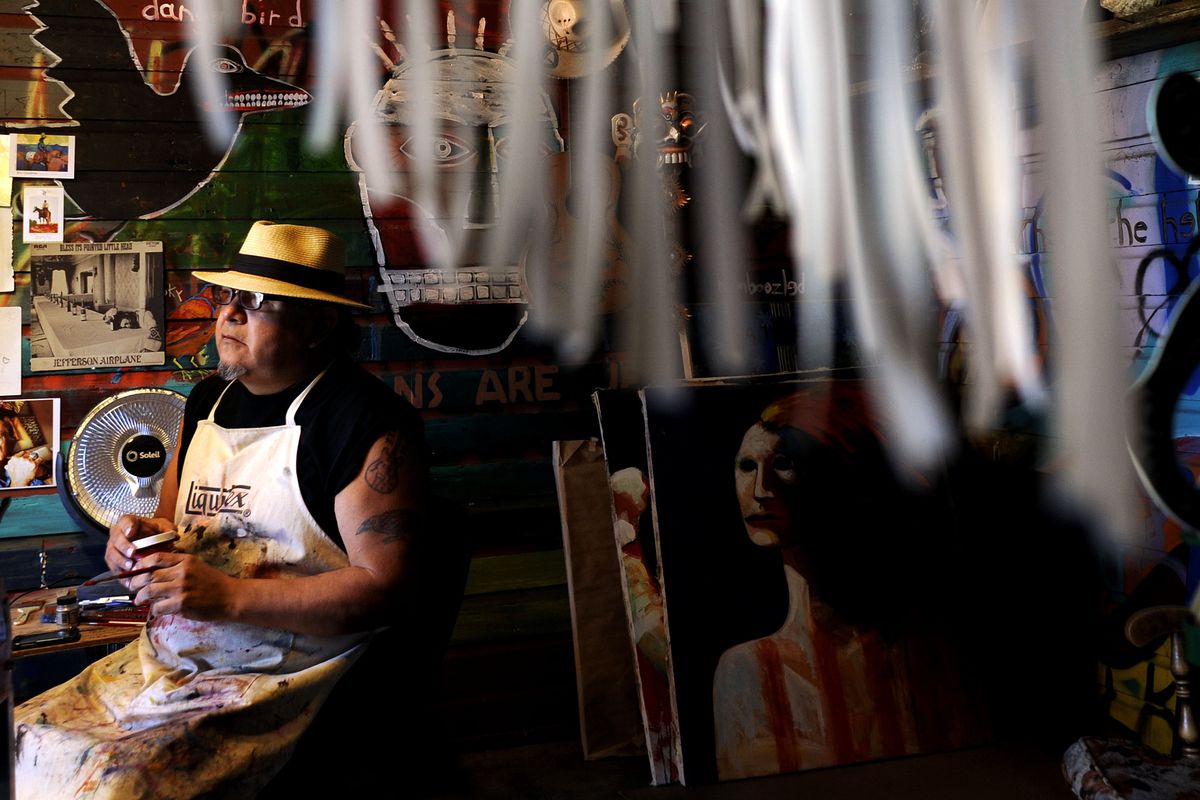‘Moody, broody’ beauty
Gendron’s paintings, on display in CdA, rich with music, culture, ‘twisted’ figures

His studio is half a garage behind his house, with the door wide open to sun, lawn, quiet and dandelions in Peaceful Valley. He keeps painting after the sun goes down, with lights aimed at the canvas or paper on his easel.
He paints every day, but if he makes a plan for a day’s work, it’s vague. Maybe he’ll paint a skull today, or maybe an Indian guy.
Everything Ric Gendron starts eventually turns into something. But sometimes it takes awhile.
“If you look at any of my paintings, you’re almost guaranteed that there’s at least one other painting underneath it,” he said.
Thirty years into his career as a painter, Gendron is on the front end of a multistate tour of his exhibition “Ric Gendron: Rattlebone,” which ended a five-month run at the Missoula Art Museum in March. He’s getting recognized by patrons, questioned about his work and the book by the same name published in conjunction with the show. People are buying his paintings.
He’ll take another trip today to an opening reception in downtown Coeur d’Alene, where more than 30 pieces of his newest work will be shown at the Art Spirit Gallery.
His career has taken a turn. After raising three children as a single father, and recalling when a $25 sale was a very big deal, he was “kind of knocked out” by his show’s good reception in Missoula.
“For me, it matters,” he said. “This is the way I pay my bills.”
Gendron’s big midcareer show almost didn’t happen. A planned major exhibition of his work was canceled in 2010 by the budget-strapped Northwest Museum of Arts & Culture, and its curator, Ben Mitchell, laid off. For Gendron, the cancellation was devastating. Unable to paint, he felt “squashed,” he told a friend quoted in a Spokesman-Review article in 2011.
But Mitchell and other supporters of Gendron’s work rallied to launch the exhibit and create the book. “Rattlebone” heads next to exhibition spaces in Pendleton, Ore.; La Conner, Wash.; and Santa Fe, N.M., before a two-month show at the Jundt Art Museum at Gonzaga University starting in January 2015.
At the Missoula exhibition, patrons seemed appreciative, Mitchell said, drawn by the narratives embedded in Gendron’s paintings and by “something more than a surprising use of color. His color is so bold and vibrant.”
Meanwhile, back in the garage, Gendron keeps painting. Every day.
Steve Gibbs, who owns the Art Spirit Gallery, said the new works on display there are varied and vibrant. They include pieces portraying a sort of carnival show – a fan dancer, a fire breather, a balancing act.
“He paints out of his head,” Gibbs said, with enough years behind the brush to make those images come alive, spontaneous and fresh.
Gendron is a guitarist, and musicians, and music, show up often in his paintings – references to traditional and contemporary Native American music along with blues, country, folk and rock. His most recognizable work to Spokane residents may be the 30-foot-tall portraits of T-Bone Walker, Hank Williams, John Lennon and John Coltrane at Hotel Ruby at First Avenue and Lincoln Street.
Ravens show up frequently, too, on their own or standing on people’s heads. There are many portraits of Native Americans, both historical figures and ones Gendron imagines. One of 10 siblings, Gendron was born on the edge of the Colville Reservation to a Colville father and Umatilla mother.
Some figures in his paintings have wide mouths with straight lines of white teeth that extend beyond their faces. He’s been caught up in the figures with the teeth, he said – “morbid, twisted” beings.
Many of the people in his paintings, actually, are Gendron, he said.
“I do a lot of self-portraits that do not look like me,” he said, “but emotionally they’re correct.”
“Converting the Heathens” shows a figure on a cross, bindings across his legs. It has to do with being raised in a “very Catholic” family, he said. He’s a spiritual person, he said, but no longer Catholic, “not even Christian.”
His personality is “kind of dark, moody, broody,” he said. “That’s what I like to convey. Happy little paintings don’t do it for me.”